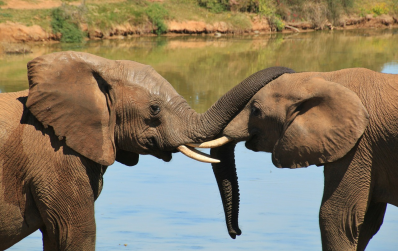Headings and subheadings: African elephant
The Grammar Bit!
Find out more about the African elephant by reading the information text opposite. You’ll notice that it includes a main heading (underlined) to help the reader understand what the whole text is about.
You’ll notice that it also contains several subheadings (bold). Subheadings break up the text into interesting chunks or paragraphs of information for the reader to enjoy and learn from. If the reader is looking for a specific piece of information, a sub-heading can act as a quick guide.
Once you have read the whole text, with your talk partner, give the heading and each subheading a star rating
1 star = OK
2 stars = good
3 stars = excellent
Be prepared to explain your star ratings!
(Teacher’s note: Capitalisation in headings and subheadings can take various forms. The key at this level is to encourage consistency.)
Scintillating Sentences
The African Elephant
An African elephant’s diet
An African elephant is a plant-eating mammal that can live for up to 70 years in the wild. To fuel its enormous body, an adult will eat up to 300 kg of vegetation in a single day.This will include roots, grasses, fruit, and bark.
Herd life
Elephants live in female-led groups. The group is led by the biggest and oldest female, who is known as the matriarch. Her group will include her daughters and their young. Adult males, called bulls, tend to roam on their own, sometimes forming smaller, all-male groups.
The challenges a baby elephant faces
A baby elephant is called a calf. For the first 2 to 3 months of its life, it stays very close to its mother. At this young age, it doesn’t really know how to use its trunk and needs lots of guidance from mum. Baby elephants are vulnerable to attack by predators such as lions, but there are usually plenty of family members around to keep them out of harms way.

Did you know?
An elephant’s trunk is actually a long nose used for smelling and breathing, as well as grabbing things, drinking and trumpeting. It contains 40,000 muscles!

